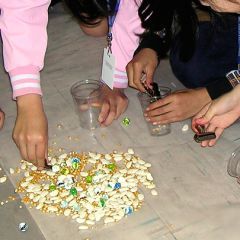Grade Level(s):
- 6-8
- 9-12
Source:
- UC Museum of Paleontology
Resource type:
- classroom activity
Discipline:
- Life Science
Time: one class period
Overview
In this activity, students simulate bird feeding with "beaks" that differ in size. The proportion of big-, medium-, and small-beaked birds changes in response to available types of food. This is a lesson on evolution, but suggestions on how to incorporate the nature and process of science are included.

- [What is science?: Grades 6-8] Science aims to build explanations of the natural world. (P3, P6)
- [What is science?: Grades 6-8] Scientists strive to test their ideas with evidence from the natural world; a hallmark of science is exposing ideas to testing. (P3, P4, P6, P7, NOS2)
- [What is science?: Grades 6-8] Scientific knowledge is open to question and revision as new ideas surface and new evidence is discovered. (P6, NOS3)
- [What is science?: Grades 9-12] Science aims to build explanations of the natural world. (P3, P6)
- [What is science?: Grades 9-12] Scientists strive to test their ideas with evidence from the natural world; a hallmark of science is exposing ideas to testing. (P3, P4, P6, P7, NOS2)
- [What is science?: Grades 9-12] Scientific knowledge is open to question and revision as new ideas surface and new evidence is discovered. (P4, P6, NOS3)
- [How science works: Grades 6-8] Scientists look for patterns in their observations and data. (P4, P5)
- [How science works: Grades 6-8] Different scientists may interpret the same data in different ways. (P7)
- [How science works: Grades 9-12] Scientists look for patterns in their observations and data. (P4, P5, NOS2)
- [How science works: Grades 9-12] Different scientists may interpret the same data in different ways. (P7)
- NOS Matrix understanding category 2. Scientific knowledge is based on empirical evidence.
- NOS Matrix understanding category 3. Scientific knowledge is open to revision in light of new evidence.
- Science and Engineering Practice 4. Analyzing and interpreting data
- Science and Engineering Practice 5. Using mathematics and computational thinking
- Science and Engineering Practice 6. Constructing explanations and designing solutions
- Science and Engineering Practice 7. Engaging in argument from evidence
This lesson can be modified to make the nature and process of science more explicit by emphasizing the importance of sharing and analyzing data and by connecting the activity to the actual research of Peter and Rosemary Grant. Suggestions for how to do this are included at the end of the lesson.
